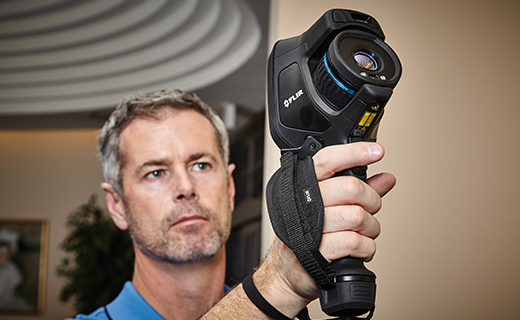MeterCare at KWx
How to calibrate a thermal imaging infrared camera in a nutshell

MeterCare – KWx’s brand-agnostic and RvA-accredited calibration centre – is mainly known for calibrating NEN 1010, NEN 3140 and Power Quality measuring equipment. In [month] 2015, thermal imager calibration was added to this list too. Calibrated blackbodies are indispensable during this process to generate accurate and traceable temperatures. Thanks to these units, MeterCare can calibrate long-wave infrared (LWIR, 8-14 μm) thermal imaging cameras with a temperature range of -20 °C to 500 °C.
In August 2021, the laboratory calibrated [number] thermal imaging cameras. Now is a good time to take our customers through the calibration process. Why do we even need to have a thermal imaging camera calibrated? We take a look at the calibration process together with Marco, one of our lab technicians, who tells us when to have a spot pyrometer and thermal imager calibrated and how this is done.
Infrared radiation maps out invisible problems
To understand why we need to calibrate thermal imagers, we first need to know where these measuring tools are used and why. Many sectors now use thermography as an inspection, measurement and/or analysis method, to detect construction or installation defects in residential and non-residential buildings, for example. By displaying thermal anomalies in detail, infrared measurements are a valuable inspection method for the medical sector, not to mention cooling and heating technology.
All objects emit infrared radiation. And just like radio waves, microwaves, and X-rays, infrared radiation is also something we can’t observe with our eyes. With an infrared camera, this spectrum is made “visible” to the human eye.
A thermal imager is equipped with a sensor, like a regular digital camera, but this sensor can record the infrared spectrum. The information that the sensor registers is then converted to a visible thermal image. The colours on the display represent the different temperatures. To further define the image, the display also shows a temperature scale and the temperature in degrees.
Reliability after a long period of time
And now here comes an important point: although professional thermal imagers will have been calibrated at the factory, they can deviate from the calibration and measurement values over time. So, it’s recommended to calibrate your thermal imager routinely – especially when detailed measurements are vital for your inspection work.
Indicative and selective temperature measurements
In simple terms, thermographic inspections are carried out in two ways: either as an indicative or selective temperature measurement. For indicative measurements, temperature differences are shown at a glance, which is useful for locating thermal bridges and pipes or detecting overloaded circuit breakers, for example. A detailed temperature display is less important in these situations.
Selective measurements are used regularly to identify wear, damage or the condition of an object over a longer period of time. For these measurements, we use infrared cameras with a high thermal resolution, low temperature sensitivity and adjustable focus. Common examples in practice are the inspection of PV installations according to SCIOS Scope 12, Research and Development applications, and continuous monitoring of electronic and mechanical installations. Thanks to these more accurate measurements, it is possible to predict when maintenance or intervention is required in advance.
“Calibrated, well-maintained measuring equipment simply does the job better”
It goes without saying that you need to be sure that your inspection camera will give the correct readings, even after prolonged use. So, regular calibration is unavoidable. Well-maintained measuring equipment simply does the job better.
When and how often you should have a thermal imager calibrated is something you will ultimately decide yourself as an employer or owner. Every year is a good rule of thumb, but this varies from company to company. KWx MeterCare technicians can determine when a device is giving inaccurate measurements, also known as drift errors, after four calibrations. This information helps us decide whether we need to adjust the calibration interval, in consultation with you.
Calibrating thermal imagers with KWx MeterCare
The KWx calibration lab is brand-agnostic, meaning it can calibrate virtually any reputable thermal imager brand. Handheld thermal imagers by manufacturers such as FLIR, Fluke and Testo regularly pass through our calibration lab.
As we do with all testing and measuring tools, after entering the thermal imager in our MeterCare database, we first perform a visual inspection to check for damage such as scratches on the lens or cracks in the housing. We also look at the quality of the battery.
Conditions for the lab environment have been laid down for our calibration procedures, which is why we allow instruments to acclimatise in our laboratory after they have arrived. In the lab, we monitor the ambient temperature and barometric pressure, among other things. These factors affect calibration and measurement results.
After a few hours of acclimatisation, we begin the calibration process. The thermal imager is placed in a fixed position, and we perform and record a series of measurements. For calibration measurements, we use a calibration blackbody with a very high emission factor. This ensures temperature measurements are accurate and measurement deviations in the thermal imager are recorded quickly.
If the calibration is completed successfully and the values are within specification, the calibration certificate is issued and returned with the thermal imager. Customers with a MeterCare account can also find their certificates and calibration data in their personal environment on our calibration portal.
Maintenance with MeterCare and Hemmink Zeker Meten
Register your measuring devices at KWx MeterCare and benefit from measurement solutions and expertise from Hemmink Zeker Meten. Then you can rest assured your measuring devices are fit for your inspection work.
Enter your details here and we will contact you to schedule a calibration, repair or update for your measuring devices.